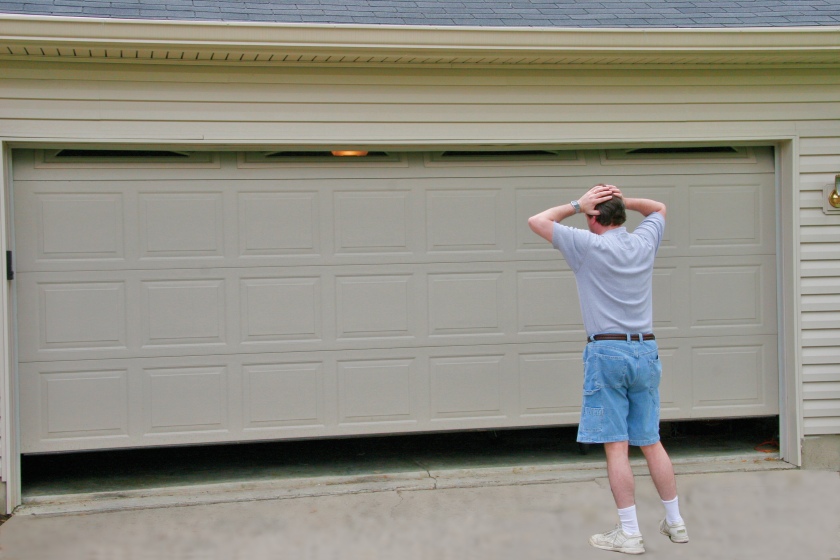Garage doors manufactured today are meant to last a lifetime, as long as you invest the time to keep them properly maintained. Much like your car, your garage door requires a periodic inspection and tune-up.
With proper care and garage door maintenance, it’s easy to keep your garage door in optimal condition. Be advised, however, that some repairs should only be done by a qualified door technician.
Here are our top garage door maintenance tips:
- TEST THE REVERSE FEATURE
While your garage door opener is technically a different set of equipment, it still impacts the overall functionality of your garage door and is important to its overall maintenance.
A reversing feature is a component of your garage door opener that is absolutely necessary. The opener should be replaced if this functionality is not available. Federal law requires any garage door opener manufactured after 1/1/1993 to have advanced safety features, and this is one of them.
To make sure your opener is compliant with these regulations, you need to test that the safety reverse systems are in order. There are two types – mechanical and photoelectric.
To test the mechanical safety reverse system place an object on the floor of the door’s opening, the door should reverse direction as soon as it hits the object.
For the photoelectric safety reverse system, stick two boxes on the vertical tracks, about 4 inches off the ground. Stick your foot in front of the photoelectric system, and see if the door opens.
Another way to test the Reverse Feature (from DASMA):
First, test the balance of the door. If the door is properly balanced, then proceed.
With the door fully open, place a 1-1/2” thick piece of wood (a 2” X 4” laid flat) on the floor in the center of the door.
Push the transmitter or wall button to close the door. The door must reverse when it strikes the obstruction. (Note that the bottom part of “one-piece doors” must be rigid so that the door will not close, but will reverse when it contacts the obstruction)
If the door does not reverse, have it repaired or replaced by a qualified technician.
- VISUALLY INSPECTING YOUR GARAGE DOOR
Check out your garage door springs, rollers, pulleys, cables and all hardware for signs of wear.
*The springs hold a great deal of tension and only professionals should adjust them. The torsion springs (the springs above the door) should only be adjusted by a professional. Do not attempt to repair or adjust torsion springs yourself.
As a precaution in case the spring breaks, the restraining cable should be installed on the extension spring (the spring along the side of the door).
- CLEANING AND LUBRICATING YOUR GARAGE DOOR
An important part of garage door maintenance is making sure the tracks, on which the door moves, are clear of debris, and screwed in tightly.
To ensure that your garage door tracks function well you will need to clean the track, removing oil, dirt, and grease.
Next, apply a small amount of lubricant to the heads of the rollers and the pivot points on the hinges. This will allow all moving parts to glide more easily in the track. You may use any lightweight oil, 30w or lighter. Make sure that you don’t miss areas like the locking hardware, and torsion spring (if present.)
After wiping excess oil, you may tighten any hinges, struts, handles, locks, and brackets that may need it.
This whole process of garage door lubrication maintenance should be done yearly. For best results, consult your owner’s manual.
- ASSESSING THE GARAGE DOOR BALANCE
Periodically testing the balance of your garage door is another important component to your routine maintenance. Here’s how:
Ensure the door is closed completely
Engage the release mechanism so you can control the door by hand
The door should then lift with little resistance. You should be able to keep it open 3-4 feet above the ground.
- INSPECTING THE WEATHER SEALS ON YOUR GARAGE DOOR
It is also important to make sure the opening of your garage door has proper weather stripping. This will help to keep debris and cold air from permeating your garage.
Look closely at the weather seals on the top, bottom, and sides, checking for any rips or tears. You should also assess the flexibility of each strip because as the strips stiffen, they lose effectiveness.
Since buying a garage door is such an investment, it makes sense to take the time and effort to keep your garage door in optimal condition. If you’d like to know more about the factors that will impact your garage door’s longevity, read up about how to protect your garage door from salt damage.
Original Article Here: GARAGE DOOR MAINTENANCE: 5 THINGS YOU NEED TO DO (DIY)
Related Article Here: Maintain a Garage Door and Opener
If you are having difficulty in doing the maintenance, you call for a professional help. Lilburn Garage Door Repair is always ready to help you anytime!
Article source here: GARAGE DOOR MAINTENANCE: 5 THINGS YOU NEED TO DO (DIY)

